Can You Eat Blueberry Pie on the Low FODMAP Diet?
Blueberry Pie on a low FODMAP diet? Yes, with paying close attention to serving size. This recipe aligns with Monash University science and all of their recommendations to bring you a pie that you can even enjoy during Elimination!
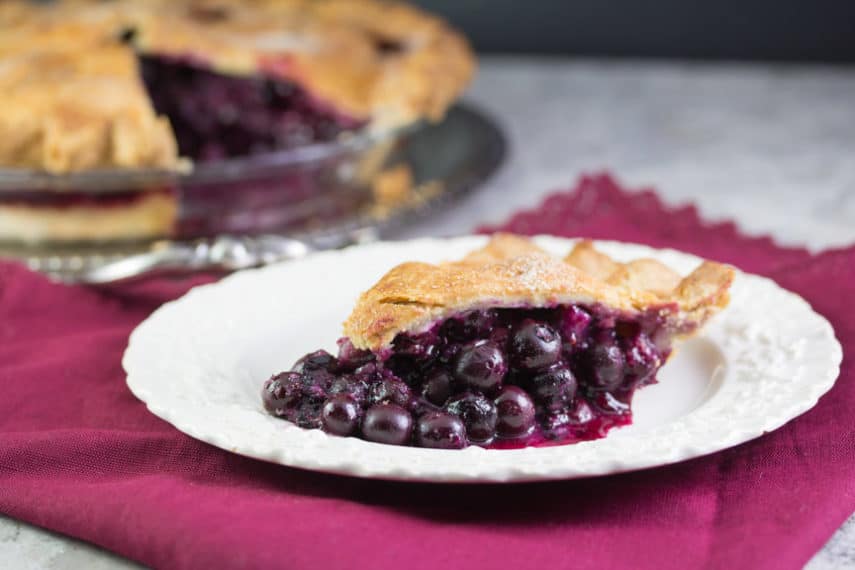
This version features our All Butter Pie Crust, which is made with low FODMAP, GF flour.
How Much Blueberry Pie Can I Eat?
Blueberries have been lab tested by both Monash University and FODMAP Friendly. FODMAP Friendly gives them a “Pass” at 1 cup or 150 g, with a maximum serve of 3 cups, or 450 g. In initial lab tests, Monash stated that a Green Light low FODMAP serving was a heaping ¼ cup or 40 g. In those initial tests the fruit jumped to Moderate FODMAP levels quickly at ⅓ cup or 50 g (for GOS). Blueberries were re-tested in late 2022 and now are considered low FODMAP at 1 cup or 125 g. Fine print states that they remain low FODMAP up to 500 g, which is the highest amount tested, not necessarily the highest amount that would remain low FODMAP. Eat to your tolerance.
In initial lab tests, Monash found blueberries to contain GOS, while FODMAP Friendly lab tests detected fructose and no GOS. All of this lab testing, which is all accurate and reflects what was tested at the time, tells us that there is a lot of variability among fresh blueberries. No one can tell you what FODMAP content your blueberries have at home right now, or at the store next week. Simply use the app entries as guides, and eat to your tolerances.
Serving Sizes Can Change, Post Challenge Phase
Dédé found out during her Challenge Phase that she can eat fairly large servings of blueberries and maybe you will find out the same – and full admission here, that slice above got a nice dollop of lactose-free yogurt as soon as it came off the photo set and was devoured as her afternoon snack.
Know your tolerances and proceed accordingly and you will be able to enjoy this hard-to-believe, but truly low FODMAP recipe.
 Pie Plate Size Matters
Pie Plate Size Matters
A note on pie plate sizes: make sure your pie plate is 9 inch (23 cm) in diameter by 1 ¼ inches (3.2 cm) deep. Similar looking plates are deep-dish pie plates and measure 9 ½ inches (24 cm) across by 1 ½ inches (4 cm) deep.
The larger size plates, which are really more of a deep-dish pie dish size, will throw off the recipe. We like to use the clear, ovenproof glass Pyrex pie plates, which are easy to find in most well-stocked supermarkets.
They conduct heat evenly and allow you to see how your crust is browning, as you can see below.
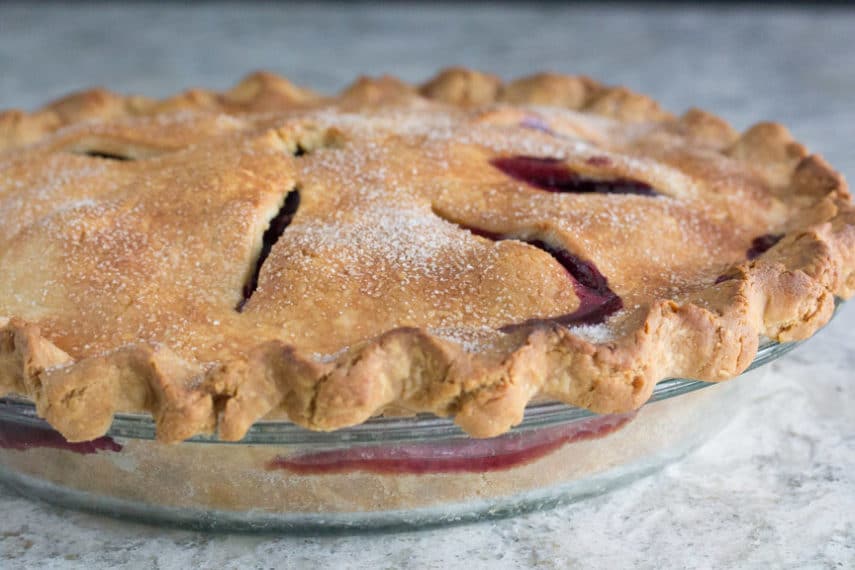
More Blueberry Lusciousness
Here are more low FODMAP blueberry recipes for you to try:
- Fresh Blueberry Pie
- Blueberry Maple Compote
- Kale Quinoa Salad with Blueberries & Feta
- Peach Blueberry Crostata
- Blueberry Muffins
- Blueberry Sour Cream Bundt Cake
- Maple Balsamic Chicken with Blueberries
- Blueberry Limeade
- Vegan Red, White & Blue Popsicles
- Flag Slab Pie
- Red, White & Blue Trifle
- Lemon Blueberry Sheet Pan Pancakes
- The Berries Pie
- Eat The Rainbow Slaw
- Berry Terrine
- Cannoli Cream
- Mixed Berry Slab Pavlova
- Hazelnut Shortcake with Berries
- And many more!
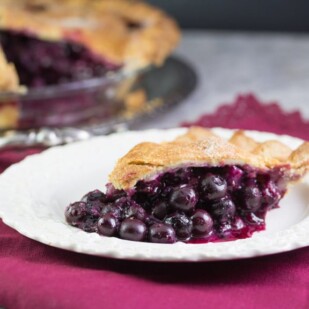
Blueberry Pie
Just like my Nana used to make – Blueberry Pie! Make when the berries are at their peak.
Low FODMAP Serving Size Info: Makes 1, 9-inch (23 cm) pie; 20 slices; serving size 1 slice
Ingredients:
Gluten Free Butter Pie Crust:
- 2 large eggs, cold
- 1/3 cup (75 ml) ice cold water
- 1/2 teaspoon apple cider or distilled white vinegar
- 2 1/2 cups (363 g) low FODMAP gluten-free all-purpose flour, plus extra for rolling, such as Bob's Red Mill 1 to 1 Gluten-Free baking Flour
- 1 tablespoon sugar
- 1/2 teapoon xanthan gum
- 1/2 teaspoon salt
- 1 cup (2 sticks; 226 g) very cold unsalted butter, cut into tablespoon sized pieces
Blueberry Filling:
- 3 dry pints (1653 ml) fresh blueberries, washed, picked over and patted dry
- 1/4 cup (28 g) cornstarch
- 1 cup (198 g) sugar plus extra
- 1 teaspoon fresh squeezed lemon juice
- 1 tablespoon unsalted butter, cut into large pieces
- 1 tablespoon lactose free whole milk, 2%, 1% or fat free, optional
Preparation:
-
For the Crust: Position one oven rack at highest position or wherever your oven is hottest and another rack lower down. Preheat oven to 400°F/200°C. Line the bottom of your oven with a sheet of aluminum foil to catch drips.
-
Whisk the eggs, water and vinegar together in a 2 cup (480 ml) measuring cup with spout and refrigerate until needed.
-
To Make by Hand: Whisk together the flour, sugar, if using, xanthan gum and salt in a medium bowl to blend. Add the butter and cut in, using a pastry blender or two knives, until the butter is cut into assorted sized pieces ranging from approximately ⅛ inch to ½ inch (3mm to12 mm). Sprinkle wet mixture over the dry and toss with fingers or a fork until evenly moistened and the dough just holds together if squeezed.
-
To Make in a Stand Mixer: Put the flour, sugar, if using, xanthan gum and salt in the stand mixer bowl. Using flat paddle attachment, turn on low speed to blend dry ingredients. Add the butter and pulse on and off until the butter is cut into assorted sized pieces ranging from approximately ⅛ inch to ½ inch (3mm to12 mm). Sprinkle wet mixture over the dry and pulse on and off until dough is evenly moistened and the just holds together if squeezed.
-
To Make with a Food Processor: Put the flour, sugar, if using, xanthan gum and salt in the bowl of a food processor fitted with the metal blade attachment and pulse to combine. Add the butter and pulse on and off until the butter is cut into assorted sized pieces ranging from approximately ⅛ inch to ½ inch (3mm to12 mm). Sprinkle wet mixture over the dry and pulse on and off until dough is evenly moistened and the just holds together if squeezed.
-
To Finish for All Techniques: Empty dough onto work surface and use hands to bring together gently. Divide in half, form each portion into a ball and flatten. This dough may be rolled out right away either on a lightly floured surface or between two pieces of parchment paper. You can also make ahead and refrigerate for up to 2 days or freeze for up to 1 month, in which case protect it further by placing in a plastic zipper-top bag; defrost in the refrigerator overnight. Let the dough soften slightly at room temperature before rolling out.
-
For the Filling: Place about one-quarter of the blueberries (just eyeball it) in a mixing bowl with cornstarch. Use a potato masher to mash the berries to encourage some moisture to combine with the cornstarch. Add remaining berries, 1 cup (198 g) of sugar and the lemon juice. Fold together very well to mix. Allow to sit for 15 minutes, folding well once or twice.
-
Coat a 9 inch (23 cm) pie plate with nonstick spray. Roll out bottom crust on work surface lightly dusted with extra flour to a 13 inch (33 cm) diameter circle and about ⅛ inch (3 mm) thick; gently fit into pie plate.
-
Pile fruit mixture into pie crust. Dot with butter. Refrigerate while rolling out top crust.
-
Roll out top crust on lightly flour dusted surface to about a 12 inch (30.5 cm) diameter and ⅛ inch (3 mm) thick and place on top of berries. Seal edges of both crusts together and trim away any excess, leaving about a 1 inch (2.5 cm) overhang. Fold both edges under and crimp. Use a sharp paring knife to make steam vents and a center hole in the top crust. Brush top of pie with milk and sprinkle with extra sugar if you like. Place pie in oven on hottest rack and bake for 30 minutes. Check to see how pie is browning, rotating pie from front to back for even baking. Cover loosely with aluminum foil at any point to prevent over-browning. Continue to bake for approximately 20 to 30 minutes more or until crust is golden brown and filling is bubbling. Cool pie on wire rack for at least 30 minutes before serving to allow juices to thicken.
-
Serve warm or at room temperature, with or without lactose-free vanilla ice cream or a dollop of lactose-free yogurt (for breakfast!). Pie may be stored at room temperature overnight lightly covered with foil.
Notes:
Tips
- If you want to use frozen berries, simply measure out 6 cups (1.4 L) directly from the freezer and proceed with recipe but allowing the berry/sugar mixture to sit for 25 minutes. The baking time might be a tad longer.
- If you do not have any cornstarch in the house and want to use more of the GF flour, use a total of ⅓ cup (54 g). This approach does have a tendency to clump up in the filling, so make sure to fold the berries and flour together very well before, during and after their sitting time.
Nutrition
All nutritional information is based on third-party calculations and should be considered estimates. Actual nutritional content will vary with brands used, measuring methods, portion sizes and more. For a more detailed explanation, please read our article Understanding The Nutrition Panel Within Our Recipes.
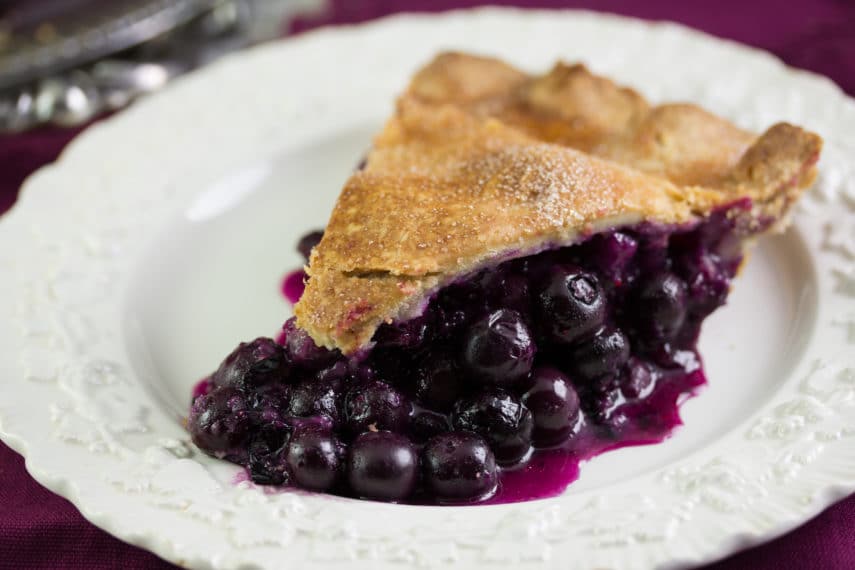 Pie Plate Size Matters
Pie Plate Size Matters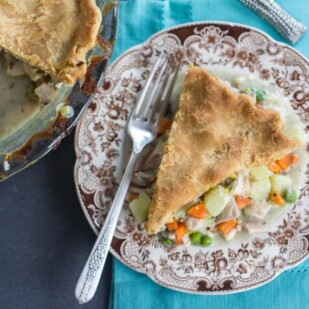
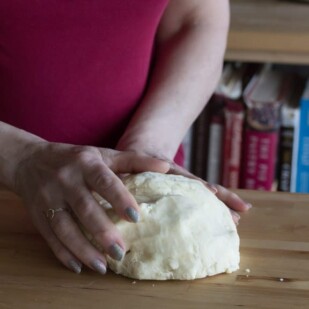






One twentieth of a pie.
I have no words.
Marla, we hope you read the whole recipe. If you did, you learned that the slice pictured, which is far greater than 1/20th of a pie, is tolerated by me quite well. Have you gone through a well-structured Elimination and Challenge Phase yet? They are vital, as it is how you will learn what YOUR tolerance to blueberries is. The Monash lab-tested approved low FODMAP amounts of blueberries are just that. But you are not a lab. Your IBS might be triggered by more or less of this amount. The lab-tested amounts are what we START with for recommendations. When you work through the stages of the diet, hopefully with a FODMAP savvy RD, you will learn your own personal tolerances. Don’t give up! Let us know how you do – we might be able to enjoy pie together!
I also wondered how to cut a pie into 20ths. Could the pie be made as a slab? What would be the correct size slab to make 20 servings?
You cut wedges into the suggested #. I am actually not sure what the confusion is, although you are not the first to wonder. The pie will not work as a slab. It has not been tested and the proportions of crust to filling are totally different in slab pies. I do not recommend it.
Thanks. It’s good to know the recipes may not work if modified.
And looking at the recipe more closely, your directions are quite clear.
Appreciate the work you’ve done with this site. It makes approaching a low fodmap diet much less daunting!
Thank you Molly! We work hard to make it easier for you:)
Just made this delicious pie. Have been making fruit pies with different crust recipes from different fodmap sites. And I have to say that this butter crust is the best I have eaten. The texture is top notch, flaky, just outta this world.
However, I shall be making a couple of tweaks by adding another tbsp of sugar to the crust, par baking it and adding an egg wash coating before filling it. It was rather soggy with the filling (which was so delicious, thank you so much!) first time round.
Oh, and good news too from Monash with its reassessment of fodmaps in blueberries. This is undoubtedly one of the best blueberry pie recipes I’ve come across. I shall be letting you know how it goes second time round with my little adjustments. Thanks once again for a delicious dessert.
Thank you for writing. I am very proud of that crust! LOL…I also suggest that you try the cream cheese crust as well. Re: blueberries, we are not updating older content because all the new testing tells us is that some blueberries can be this, and some can be that, and most importantly, the ones you buy could be altogether different! So glad you tolerate them and enjoyed a juicy pie.